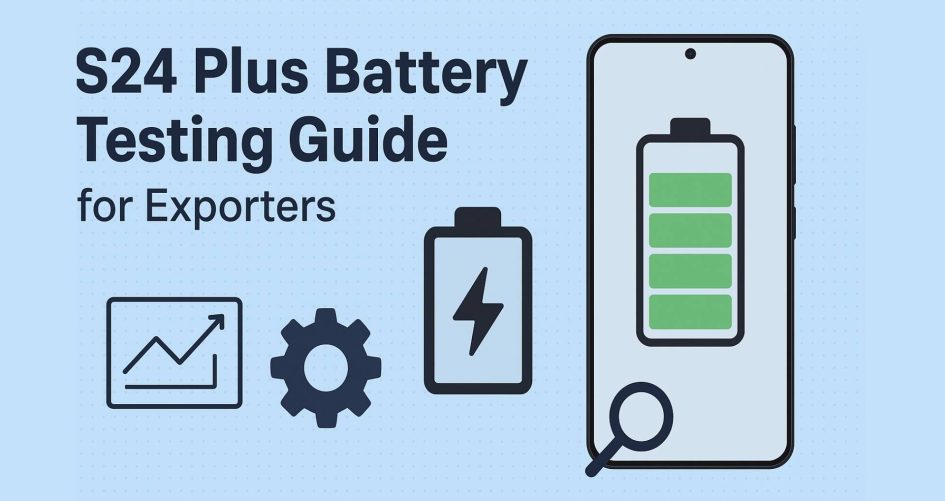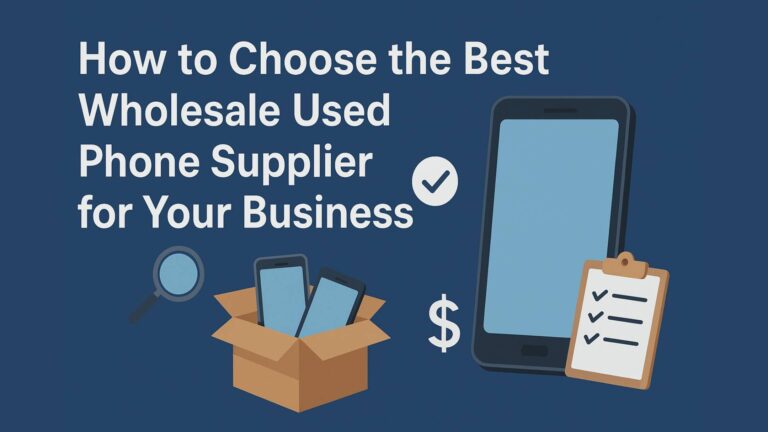For refurbished mobile exporters, ensuring that every shipment meets international quality expectations is critical. When it comes to the Samsung S24 Plus, battery performance is a key selling point. Conducting a thorough S24 Plus battery test before dispatch is not only a compliance measure but also a competitive advantage in the Samsung battery export market. Integrating strong refurb QA practices can mean the difference between repeat customers and costly returns.
In this guide, we’ll walk you through battery testing standards, compliance for export, and professional refurbishment quality assurance. Know more.
Why Battery Testing Matters for Exporters
When exporting refurbished smartphones, especially premium models like the Samsung S24 Plus, the battery is one of the most scrutinized components.
- Customer Trust – Buyers expect reliable battery life and safety from a Samsung battery export shipment.
- Regulatory Compliance – Many countries have strict import requirements for lithium-ion batteries, making a proper S24 Plus battery test essential.
- Refurb QA Standards – Strong refurb QA processes prevent defective units from leaving your warehouse.
Overview of the S24 Plus Battery Specifications
Before diving into testing, it’s important to understand the battery’s design:
- Capacity: Around 4,900 mAh
- Type: Lithium-ion polymer
- Fast Charging: Up to 45W supported
- Cycle Life: Typically 500–800 charge cycles before notable degradation
Understanding these specs ensures your S24 Plus battery test results are accurate and relevant for Samsung battery export checks.
Core Steps in S24 Plus Battery Testing
1. Initial Visual Inspection
Check for swelling, cracks, corrosion, or broken connectors. Physical damage immediately disqualifies the battery from Samsung battery export eligibility.
2. Voltage Check
Use a digital multimeter to ensure the battery voltage is within the safe range (3.7V–4.35V). Low voltage can indicate deep discharge damage.
3. Capacity Test
A proper S24 Plus battery test includes a controlled discharge and recharge to measure real capacity. The result should be at least 80% of the original factory capacity for a refurb QA pass.
4. Internal Resistance Measurement
High resistance can cause overheating and reduced performance. For export approval, resistance should be within manufacturer tolerances.
5. Charging Efficiency Assessment
Test how quickly the battery charges and ensure it maintains stability under fast-charging protocols — an essential refurb QA metric.
Testing Tools and Equipment for Exporters
Professional exporters use a combination of manual and automated equipment for S24 Plus battery test accuracy:
- Battery Analyzer Machines – For automated capacity and cycle life testing.
- Multimeters – For spot-checking voltage and continuity.
- Thermal Cameras – To detect overheating during charging.
- Cycle Testing Stations – To simulate real-world charging patterns before Samsung battery export.
Samsung Battery Export Compliance Requirements
When shipping Samsung battery export units internationally, you must comply with:
- UN38.3 Certification – Mandatory for lithium-ion battery transport.
- MSDS Documentation – Material Safety Data Sheet to inform carriers and customs.
- IATA Guidelines – Air transport safety compliance for batteries.
- Country-Specific Import Regulations – Some countries require extra testing proof for refurb QA clearance.
Integrating Refurb QA into the Testing Process
Refurb QA is more than a checklist — it’s a systematic process that ensures each unit is export-ready:
- Documentation – Keep detailed records of each S24 Plus battery test for traceability.
- Batch Sampling – Test a statistically significant number of units from each shipment.
- Software Diagnostics – Use device-level battery health reports to supplement hardware tests.
- Final Sign-off – Only units passing all refurb QA checks move to packaging.
Common Battery Issues Found in Refurb Units
During S24 Plus battery test inspections, exporters often encounter:
- Capacity Drop – Batteries with under 80% capacity are unsuitable for Samsung battery export.
- Overheating – Can indicate internal cell damage.
- Voltage Fluctuations – Suggests unstable cell chemistry.
- Fast-Charging Failures – Usually due to degraded charging circuits.
Best Practices for Battery Testing in Bulk Export
- Maintain climate-controlled storage to prevent self-discharge.
- Use automated battery analyzers to speed up refurb QA.
- Train staff on safety protocols for handling lithium-ion batteries.
- Schedule periodic calibration of testing equipment for consistent S24 Plus battery test accuracy.
How Battery Test Data Supports Sales and Marketing
Exporters can use S24 Plus battery test data to boost buyer confidence:
- Include test results in product listings.
- Provide certificates of refurb QA compliance.
- Highlight passing rates for Samsung battery export shipments in marketing campaigns.
Latest Trends in Battery Testing for Exporters
- AI-Powered Diagnostics – Predicting battery lifespan based on usage patterns.
- Blockchain Certification – Tamper-proof proof of S24 Plus battery test results for buyers.
- Automated Sorting Systems – Speed up refurb QA in high-volume warehouses.
Case Study – How an Exporter Reduced Returns by 40%
A Dubai-based refurbisher integrated advanced battery analyzers into their S24 Plus battery test workflow. They improved pass-rate accuracy and aligned with all Samsung battery export regulations. By documenting every refurb QA step, they gained trust with overseas buyers and reduced return rates dramatically.
FAQs
Q1: What’s the minimum acceptable capacity for S24 Plus battery export?
A: At least 80% of the original factory capacity for refurb QA approval.
Q2: How often should test equipment be calibrated?
A: Every 3–6 months for accurate S24 Plus battery test readings.
Q3: Can I export batteries without UN38.3 certification?
A: No, this is mandatory for Samsung battery export compliance.
Q4: Do refurbished batteries perform as well as new ones?
A: With proper refurb QA, they can match or closely approach new battery performance.
Q5: What’s the safest way to store batteries before export?
A: In a cool, dry, and climate-controlled facility.
Q6: How can I prove battery quality to buyers?
A: Provide detailed S24 Plus battery test reports and refurb QA certificates.
Conclusion
For exporters, mastering the S24 Plus battery test process is essential to maintaining a strong reputation in the Samsung battery export industry. By embedding thorough refurb QA practices, you not only meet compliance requirements but also increase customer trust and reduce costly returns. A strong testing process isn’t just about avoiding problems — it’s about building a reliable brand in the refurbished mobile export market. Know more.





